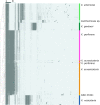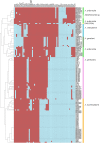Genomic sequence analysis reveals diversity of Australian Xanthomonas species associated with bacterial leaf spot of tomato, capsicum and chilli
- PMID: 31014247
- PMCID: PMC6480910
- DOI: 10.1186/s12864-019-5600-x
Genomic sequence analysis reveals diversity of Australian Xanthomonas species associated with bacterial leaf spot of tomato, capsicum and chilli
Abstract
Background: The genetic diversity in Australian populations of Xanthomonas species associated with bacterial leaf spot in tomato, capsicum and chilli were compared to worldwide bacterial populations. The aim of this study was to confirm the identities of these Australian Xanthomonas species and classify them in comparison to overseas isolates. Analysis of whole genome sequence allows for the investigation of bacterial population structure, pathogenicity and gene exchange, resulting in better management strategies and biosecurity.
Results: Phylogenetic analysis of the core genome alignments and SNP data grouped strains in distinct clades. Patterns observed in average nucleotide identity, pan genome structure, effector and carbohydrate active enzyme profiles reflected the whole genome phylogeny and highlight taxonomic issues in X. perforans and X. euvesicatoria. Circular sequences with similarity to previously characterised plasmids were identified, and plasmids of similar sizes were isolated. Potential false positive and false negative plasmid assemblies were discussed. Effector patterns that may influence virulence on host plant species were analysed in pathogenic and non-pathogenic xanthomonads.
Conclusions: The phylogeny presented here confirmed X. vesicatoria, X. arboricola, X. euvesicatoria and X. perforans and a clade of an uncharacterised Xanthomonas species shown to be genetically distinct from all other strains of this study. The taxonomic status of X. perforans and X. euvesicatoria as one species is discussed in relation to whole genome phylogeny and phenotypic traits. The patterns evident in enzyme and plasmid profiles indicate worldwide exchange of genetic material with the potential to introduce new virulence elements into local bacterial populations.
Keywords: CAZymes; Cell wall degrading enzymes; Pan genome; Secretion system.
Conflict of interest statement
Ethics approval and consent to participate
NA
Consent for publication
NA
Competing interests
The authors declare that they have no competing interests.
Publisher’s Note
Springer Nature remains neutral with regard to jurisdictional claims in published maps and institutional affiliations.
Figures






Similar articles
-
Population Dynamics of Xanthomonads Associated with Bacterial Spot of Tomato and Pepper during 27 Years across Taiwan.Plant Dis. 2018 Jul;102(7):1348-1356. doi: 10.1094/PDIS-04-17-0465-RE. Epub 2018 May 2. Plant Dis. 2018. PMID: 30673574
-
Independent Evolution with the Gene Flux Originating from Multiple Xanthomonas Species Explains Genomic Heterogeneity in Xanthomonas perforans.Appl Environ Microbiol. 2019 Oct 1;85(20):e00885-19. doi: 10.1128/AEM.00885-19. Print 2019 Oct 15. Appl Environ Microbiol. 2019. PMID: 31375496 Free PMC article.
-
Genomic Inference of Recombination-Mediated Evolution in Xanthomonas euvesicatoria and X. perforans.Appl Environ Microbiol. 2018 Jun 18;84(13):e00136-18. doi: 10.1128/AEM.00136-18. Print 2018 Jul 1. Appl Environ Microbiol. 2018. PMID: 29678917 Free PMC article.
-
Advances and Challenges in Bacterial Spot Resistance Breeding in Tomato (Solanum lycopersicum L.).Int J Mol Sci. 2020 Mar 3;21(5):1734. doi: 10.3390/ijms21051734. Int J Mol Sci. 2020. PMID: 32138355 Free PMC article. Review.
-
Durability of resistance in tomato and pepper to xanthomonads causing bacterial spot.Annu Rev Phytopathol. 2009;47:265-84. doi: 10.1146/annurev-phyto-080508-081752. Annu Rev Phytopathol. 2009. PMID: 19400644 Review.
Cited by
-
Exploring the genetic makeup of Xanthomonas species causing bacterial spot in Taiwan: evidence of population shift and local adaptation.Front Microbiol. 2024 May 23;15:1408885. doi: 10.3389/fmicb.2024.1408885. eCollection 2024. Front Microbiol. 2024. PMID: 38846563 Free PMC article.
-
Proteome Analysis of Walnut Bacterial Blight Disease.Int J Mol Sci. 2020 Oct 9;21(20):7453. doi: 10.3390/ijms21207453. Int J Mol Sci. 2020. PMID: 33050347 Free PMC article.
-
Comparative Genomic Analysis of the Lettuce Bacterial Leaf Spot Pathogen, Xanthomonas hortorum pv. vitians, to Investigate Race Specificity.Front Microbiol. 2022 Apr 18;13:840311. doi: 10.3389/fmicb.2022.840311. eCollection 2022. Front Microbiol. 2022. PMID: 35516433 Free PMC article.
-
Responses of Soybean Genes in the Substituted Segments of Segment Substitution Lines Following a Xanthomonas Infection.Front Plant Sci. 2020 Jul 2;11:972. doi: 10.3389/fpls.2020.00972. eCollection 2020. Front Plant Sci. 2020. PMID: 32719700 Free PMC article.
-
Phylogenetic Analyses of Xanthomonads Causing Bacterial Leaf Spot of Tomato and Pepper: Xanthomonas euvesicatoria Revealed Homologous Populations Despite Distant Geographical Distribution.Microorganisms. 2019 Oct 16;7(10):462. doi: 10.3390/microorganisms7100462. Microorganisms. 2019. PMID: 31623235 Free PMC article.
References
-
- Potnis N, Timilsina S, Strayer A, Shantharaj D, Barak JD, Paret ML, Vallad GE, Jones JB. Bacterial spot of tomato and pepper: diverse Xanthomonas species with a wide variety of virulence factors posing a worldwide challenge. Mol Plant Pathol. 2015;16(9):907–920. doi: 10.1111/mpp.12244. - DOI - PMC - PubMed
-
- Garita-Cambronero J, Palacio-Bielsa A, Lopez MM, Cubero J. Pan-genomic analysis permits differentiation of virulent and non-virulent strains of Xanthomonas arboricola that cohabit Prunus spp and elucidate bacterial virulence factors. Front Microbiol. 2017;8:573. doi: 10.3389/fmicb.2017.00573. - DOI - PMC - PubMed
-
- Roach R, Mann R, Gambley CG, Shivas R, Rodoni B. Identification of Xanthomonas species associated with bacterial leaf spot of tomato, capsicum and chilli crops in eastern Australia. Eur J Plant Pathol. 2017;150(3):595–608. doi: 10.1007/s10658-017-1303-9. - DOI
MeSH terms
LinkOut - more resources
Full Text Sources

